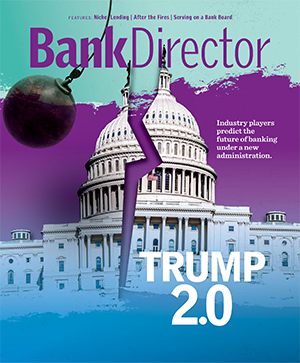
Strategy Before Structure
Brought to you by docfox

Imagine this scenario: A bank executive meets with an innovative and forward-thinking tech leader and is immediately taken in by their offering. They think it would make a lot of sense for their bank and ask the tech leader to meet with the rest of the bank team, who are similarly impressed. They do their due diligence and find that all of the tech company’s customers give them glowing reviews.
They move forward, and after some time and effort the product launches. Everyone is excited … until the product falls completely flat and ends up doing nothing to help the bank do business better. What happened?
Unfortunately, too many banks work with vendors without considering whether their products actually fit into the larger strategy of their bank first. Instead, they do the opposite: They mold their strategy around the technology vendor they end up working with.
In these situations, the principle of strategy before structure is really important. Are the actions you and your bank are taking defined by your strategy? Or is your strategy being driven by your vendors? It should always be the former.
One example that comes to mind is banks investing a lot of time and money into online lending or account opening, only to be disappointed when they are met with mostly fraud and spam. Often, this is because they never built out an online marketing strategy for the software to support the new technology. Conversely, we know banks that have experienced tremendous results through the same channels – when it was part of a deliberate strategy to go online.
Building a Strategy
If the above scenario hits a little too close to home, you are not alone. But in order to keep it from happening again, there’s a few things to keep in mind moving forward:
1. Understand what is out there. It’s important for bank executives to understand what is available when it comes to new technology. Your team should be speaking with and engaging with tech leaders to understand what is possible.
You should also be speaking to other banks to find out what they are doing. Identify a banker in a different state or market where your institution doesn’t compete and ask them what tech stack they are using, both successfully and maybe not so much.
From there, take the information you gather back to your institution’s drawing board. Think about your bank’s strategy and use what you now know is possible to advance it.
2. Work with transparency. When working with vendors, it’s common for banks to be secretive about their evaluation process and which vendors they are considering. In my opinion, this is the wrong way to go about it. Working with vendors should resemble World Wrestling Entertainment’s Royal Rumble: Everyone is in the same ring and the last person standing wins.
This is the best way to ensure complete transparency and get the management team the clarity they need to make a decision. It also allows vendors to work together and balance off each other, rather than handicapping them by asking them to design a system without knowing all the pieces in play. We have seen scenarios where two seemingly competing vendors can actually come together to form a better total solution.
In my opinion, this is also the best way to cut through the noise and see who really understands your bank and strategy the best. Ask your vendors to explain the differences between them and the other organizations you are reviewing and compare notes.
3. Run a pilot program. When it’s possible, your bank should implement new tech products first as a mini or pilot program.
Find a division in your bank – or maybe even just a single banker – and let them try out the
product first. If that’s not possible, ask the vendor if they can set up a sample instance or use dummy data in a workshop before going live.
These kinds of tests allow your institution to agree on the success criteria and see if the vendor can meet them, before spending the time and energy to go live on a large scale. Any vendor worth working with should have no problem offering such an option.
With these tips in mind, bankers can be empowered to move forward with new technology and services that will actually deliver on their promises of helping their business and customers – rather than fall flat from the start.


